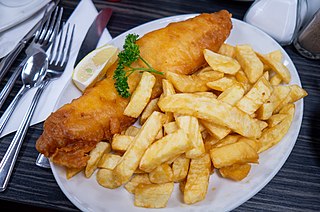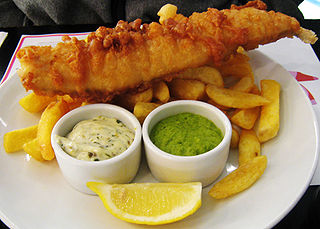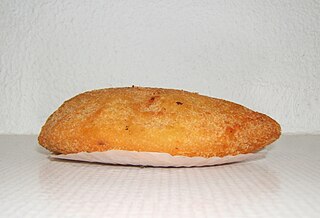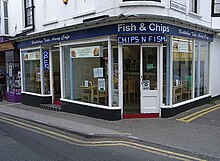
French fries, chips, finger chips, french-fried potatoes, or simply fries are batonnet or allumette-cut deep-fried potatoes of disputed origin from Belgium or France. They are prepared by cutting potatoes into even strips, drying them, and frying them, usually in a deep fryer. Pre-cut, blanched, and frozen russet potatoes are widely used, and sometimes baked in a regular or convection oven; air fryers are small convection ovens marketed for frying potatoes.

Fish and chips is a hot dish consisting of fried fish in batter, served with chips. The dish originated in England, where these two components had been introduced from separate immigrant cultures; it is not known who combined them. Often considered Britain's national dish, fish and chips is a common takeaway food in numerous other countries, particularly English-speaking and Commonwealth nations.

Gravy is a topping or sauce often made from the juices of meats that run naturally during cooking and often thickened with corn starch or other thickeners for added texture. The gravy may be further coloured and flavoured with gravy salt or gravy browning or ready-made cubes. Powders can be used as a substitute for natural meat or vegetable extracts. Canned and instant gravies are also available. Gravy is commonly served with roasts, meatloaf, rice, noodles, chips (fries), mashed potatoes, or biscuits.

Mushy peas are dried marrowfat peas which are first soaked overnight in water with baking soda, and then rinsed in fresh water, after which the peas are gathered in a saucepan, covered with water, and brought to a boil, and then simmered until the peas are softened. The mush is seasoned with salt and pepper.

Cheese fries or cheesy chips is a dish consisting of French fries covered in cheese, with the possible addition of various other toppings. Cheese fries are generally served as a lunch or dinner dish. They can be found in fast-food locations, diners, and grills mainly in English speaking countries.

A rissole is a small patty enclosed in pastry or rolled in breadcrumbs, usually baked or deep fried. The filling has savory ingredients, most often minced meat, fish or cheese, and is served as an entrée, main course, or side dish.

A steak pie is a traditional meat pie served in Britain. It is made from stewing steak and beef gravy, enclosed in a pastry shell. Sometimes mixed vegetables are included in the filling. The dish is often served with "steak chips".

Dripping, also known usually as beef dripping or, more rarely, as pork dripping, is an animal fat produced from the fatty or otherwise unusable parts of cow or pig carcasses. It is similar to lard, tallow and schmaltz.

A fishcake is a culinary dish consisting of filleted fish or other seafood minced or ground, mixed with a starchy ingredient, and fried until golden.

Pie and peas is a traditional meal in the north of England, consisting of an individual meat pie served with mushy peas and gravy.

Scottish cuisine encompasses the cooking styles, traditions and recipes associated with Scotland. It has distinctive attributes and recipes of its own, but also shares much with other British and wider European cuisine as a result of local, regional, and continental influences—both ancient and modern.

A spam fritter is a slice of Spam fried in batter. Commonly eaten with chips and mushy peas, spam fritters are served in fish and chip shops and burger bars in the UK. They were first introduced during World War II due to fish being unavailable. Spam fritters were so associated with the war that in 1995 a government memo relating to the commemoration of the 50-year anniversary of the war ending recommended "spam-fritter frying to get into the wartime spirit".

Battered sausages are a type of sausage found all across the United Kingdom, Ireland, Australia and New Zealand.

Regional street food is street food that has commonalities within a region or culture.
Barbadian cuisine, also called Bajan cuisine, is a mixture of African, Portuguese, Indian, Irish, Creole, Indigenous and British background. A typical meal consists of a main dish of meat or fish, normally marinated with a mixture of herbs and spices, hot side dishes, and one or more salads. The meal is usually served with one or more sauces.

The Fryer's Delight is a fish and chip shop in the Bloomsbury district of London, England. It was started by Italian brothers, Giovanni and Giuseppe Ferdenzi, who came from Piacenza and worked there for many years. It is said to be popular with London cab drivers.


















